
by Dr. Christopher Kelley, CAPSTONE Science Advisor/ Biology Co-Lead, University of Hawaii at Manoa
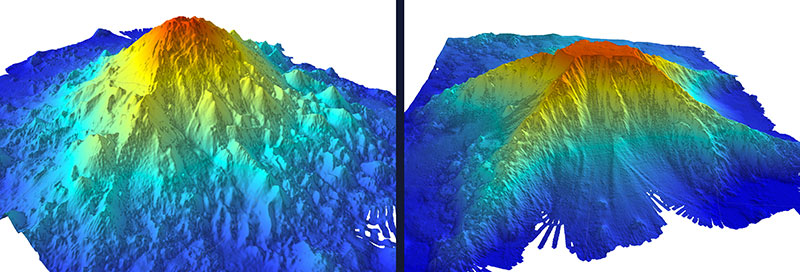
Figure 1: Conical seamount (left) and guyot (right), showing the difference in the summit morphology. Image courtesy of the NOAA Office of Ocean Exploration and Research, 2017 Laulima O Ka Moana. Download larger version (jpg, 3.8 MB).
Seamounts are volcanic constructs that protrude from the expansive and relatively monotonous abyssal seafloor. These oases in the deep can have a variety of shapes depending on what happened while they were forming, and this is particularly true of those found inside the Johnston Atoll Unit of the Pacific Remote Islands Marine National Monument, now known as Pacific Islands Heritage Marine National Monument.
These features are volcanic in origin, being born at the bottom of the ocean when lava from the mantle erupts through the seafloor. A seamount grows larger and upward as more and more lava erupts and piles up on previous eruptions. If the lava extrudes only at the summit, then the seamount will develop an overall conical shape. More often than not, cracks or "rifts" occur along the flanks allowing the lava to erupt out laterally and in a linear fashion. These ridge-like extrusions can be extenuated by landslides taking place between these "rift zones" that transform the basic conical morphology into a stellate or star-like morphology.
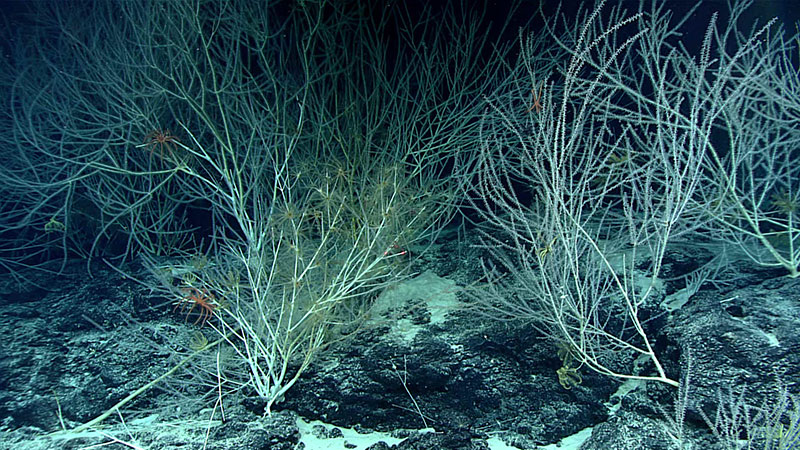
Figure 2: Large bamboo coral colonies found on ridge topography. Image courtesy of the NOAA Office of Ocean Exploration and Research, 2017 Laulima O Ka Moana. Download larger version (jpg, 1.9 MB).
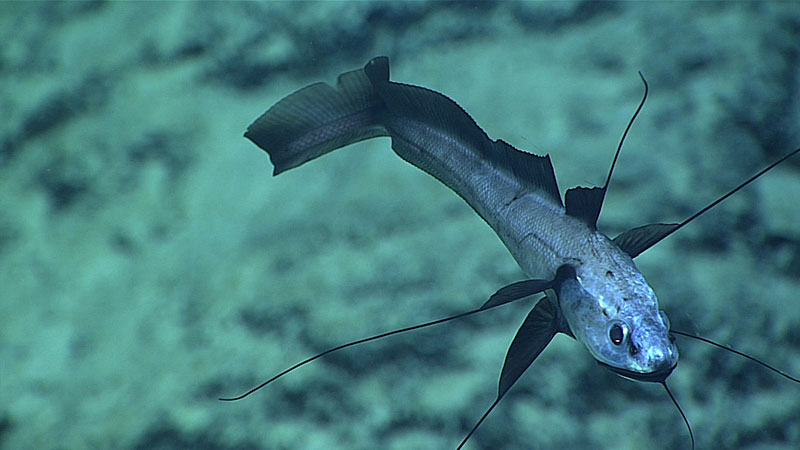
A bathygadid fish that typically prefers calmer waters. Image courtesy of the NOAA Office of Ocean Exploration and Research, 2017 Laulima O Ka Moana. Download larger version (jpg, 835 KB).
Seamounts that reach the surface to become islands can acquire a flat summit after they stop erupting and sink back down below the surface. This is due to erosion while they are still above the surface and coral reef growth along the upper flanks just below the surface. When the summits of these flat-topped seamounts sink to a depth of 200 meters, they are called guyots, named after the 19th century geographer and geologist Arnold Henry Guyot (Wikipedia).
The base and flanks of a guyot are similar to those found on a conical seamount and often have rift zone ridges and canyons formed by landslides between these ridges. The summit is where a guyot differs significantly from a conical seamount (Figure 1). A conical seamount summit is either a volcanic peak or a crater, the latter forming if the underlying magma chamber emptied and collapsed after lava stopped erupting. In contrast, the summit of a guyot is a flattened cap of terraced carbonate and sediments initially laid down by shallow-water coral and bivalve reefs when the seamount was at the surface many millions of years ago. Whatever peak was originally at the summit is long since gone, being removed by erosion and/or buried under carbonate. The relatively flat terrain on this type of summit allows sediment to continue to accumulate over time, sometimes to many meters in depth.
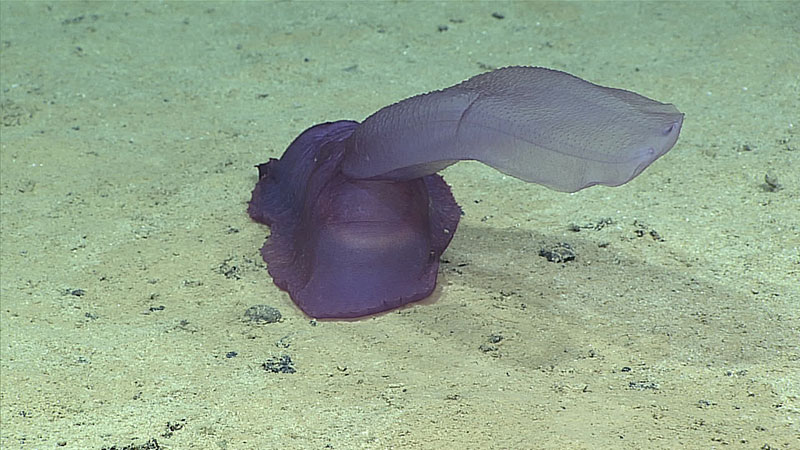
Figure 3: A sediment-dwelling sea cucumber, Psychropotes sp. Image courtesy of the NOAA Office of Ocean Exploration and Research, 2017 Laulima O Ka Moana. Download larger version (jpg, 691 KB).
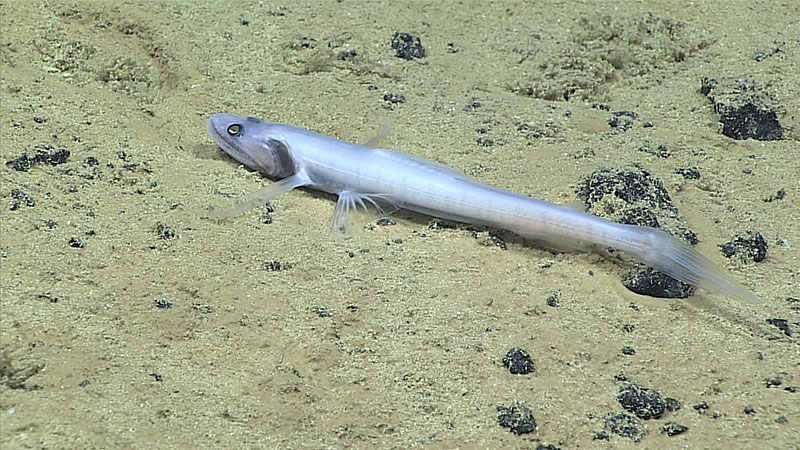
A fish, Bathysaurus sp. Image courtesy of the NOAA Office of Ocean Exploration and Research, 2017 Laulima O Ka Moana. Download larger version (jpg, 862 KB).
Animals that prefer rocky substrates live on both types of seamounts. High-current dwelling filter-feeding corals and sponges are often found on rift zone ridges, along the flanks, whereas calmer-water-dwelling invertebrates and fishes can be found in the escarpments and canyons that form between the ridges (Figure 2). Rocky substrate dwellers can easily find a home on the summits of conical seamounts but not so easily on the summits of guyots. Some exposed rock can usually be found along the edge of the summit drop-off but not near the center. The exception is where rejuvenated volcanism (eruptions that occur a long time after the seamount was formed) has created small cones protruding 200-300 meters through the thick carbonate and sediment layers. These can be thought of as micro-oases sitting on top of the seamount oasis. For the most part though, a guyot summit is where sediment-dwelling animals call home. These include shrimps, isopods, crabs, sea stars, brittle stars, sea cucumbers, sea pens, and worms of various kinds (Figure 3). Fishes, including some species of rattails and cusk eels that feed on these animals, can also be found there.
Sediment-covered guyot summits – with their terraces and, in some cases, emergent cones – provide a mixture of habitats that are not found on conical seamounts and thus may enhance the diversity of deep-sea animals living on them. Guyots are therefore potentially important to the overall ecology of the deep sea and there are a lot of them around Johnston Atoll. Guyot communities are not well understood, so like previous CAPSTONE expeditions, an important objective of this expedition is to learn more about guyot communities. Unfortunately, the flat tops that make these seamounts unique also make them the easiest type of seamount to trawl for fish or mine for minerals. It is critical that we continue to learn more about the communities they host to reduce human impacts in the deep sea.